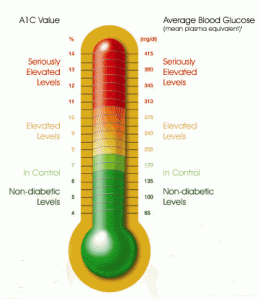Hemoglobin A1C Test for Diabetics
When it comes to managing diabetes effectively the key is proper glucose management, and the best way to check the efficiency of the patient’s glucose management regimen is with the hemoglobin a1c test. Most diabetics are familiar with checking their blood sugar by glucometer, sometimes many times daily.
So How Does the Hemoglobin A1C Test Work?
The glucometer measures the level of glucose in a drop of blood which is placed on a test strip and read by the machine. The hemoglobin a1c is also a blood test which measures the average glucose levels over a long term period.

The hemoglobin a1c test measures the amount of glucose bound to the red blood cells in this manner and therefore can give the physician a very good average of the patient’s average blood glucose level for as far back as the previous three to four months.
Since proper management of glucose levels is key to diabetes treatment and glucose levels should be kept as close to normal as possible twenty four hours a day, seven days a week, day and night, the hemoglobin a1c test is an invaluable aid.
People without diabetes have and A1C of less than 6 per cent. An A1C of more than 8 per cent suggests persistently elevated glucose levels.
You should aim to keep your A1C as low as possible, especially if you are young, but also to reduce your risk of hypoglycaemia. Your own targets should take into account your age, lifestyle, work practices, life expectancy, risk of diabetes complications and side effects and a host of other factors.
The diabetic patient may check their sugar many times daily, but only the hemoglobin a1c test can give and average which includes round the clock glucose levels.
Diabetes Maintenance with Hemoglobin A1C Test
By using the hemoglobin a1c test the patient and physician can work together to make the type of medication, diet, and lifestyle changes which will keep the patient’s blood glucose level as normal as possible, as much as possible.
Managing your glucose levels requires teamwork in which you are the central player. The best way to stay in control is to harness the support of your diabetes care team. Involve your whole family and work mates as a team to optimize your diet, organise activities and improve everyone’s health!




